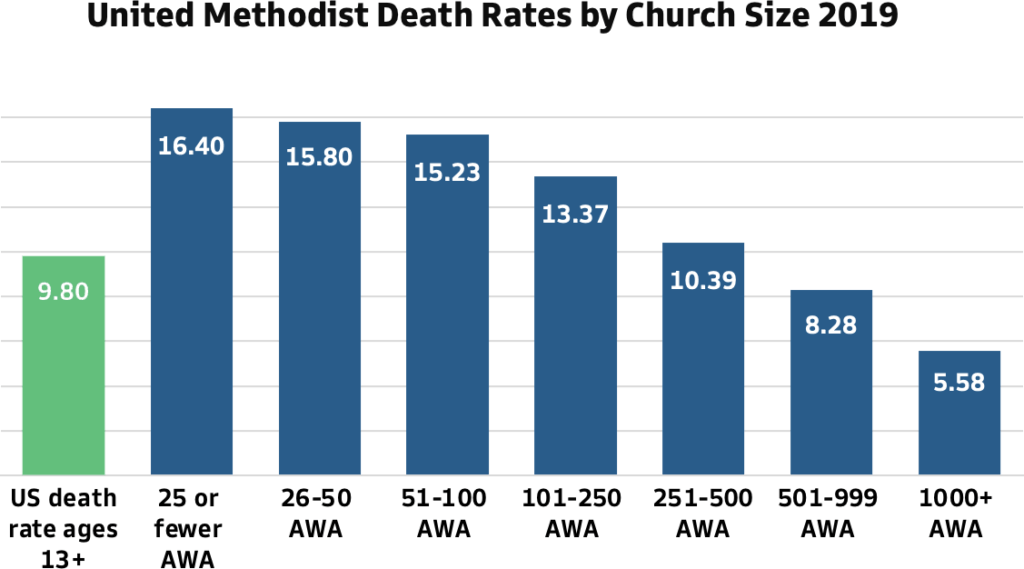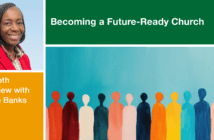Research undertaken by the Lewis Center’s Religious Workforce Project confirms that the over-representation of older people in churches has become more pronounced. Lovett Weems unpacks factors related to this trend and identifies six ways a church can respond to an aging membership base.
The Religious Workforce Project of the Lewis Center is a multiyear effort to understand the changing religious landscape in the 21st century. Funded by the Lilly Endowment, Inc., the project explores how congregations are adapting, especially in their workforce. This article is part of a series featuring insights from the research.
Few will be surprised that the Religious Workforce Project confirmed the aging of members in U.S. congregations. The over-representation of older people in churches is not new but has become more pronounced in recent decades. The latest National Congregations Study indicated that in 2018-19, 43 percent of the adults in the average congregation were over 60 years old, up from 29 percent in 1998. And 24 percent of the adults in the average congregation in 2018-19 were younger than 35, down from 30 percent twenty years earlier. Faith Communities Today found in their 2020 study that, on average, 33 percent of congregational participants are 65 or older while only 17 percent of the general population is over 65.
Sociologist Mark Chaves notes that while people are living longer and the overall U.S. population has grown older in the last 50 years, these trends do not account for the degree of aging among frequent worshipers. The most recent National Congregations Study confirms the work of other observers in noting the two age-related trends that together result in the declining religious participation in the United States: First, active participants are getting older and, as they do, participate in decreasing numbers due to health and death. Second, younger generations, always less active in religious life, are participating at significantly lower levels than the young at comparable ages did in the past.
Differences across various religious tradition and denominations
Differences in the age of congregants across religious traditions is shown in work by the Pew Research Center. Mainline Protestants tend to be the oldest of the four broad traditions they study. Catholic and Evangelical Protestants are somewhat younger. Historically Black Protestants are the youngest, though they tend to be older than the overall makeup of the U.S. adult population. Furthermore, those claiming no religious affiliation are even younger. There are also differences within denominations of these traditions reflected in the median age of their members. In some cases, individual denominations may be older than their broader religious tradition as a whole. For example, the Presbyterian Church in America, an evangelical denomination, has one of the highest median ages among denominations.
Size of congregation
In addition to surveys, death rates can give clues about age patterns by comparing church death rates with the death rates of the general population. Death rates correspond generally to age since 75 percent of deaths in recent years occurred among people aged 65 and older. Death rates for the U.S. population are figured based on deaths per 1,000 population for those ages 13 or older and for denominations, as deaths per 1,000 members each year. (Limiting population deaths to those 13 or older is indicated because younger children are often not formal members.) Among United Methodist churches, there is a strong correlation between the size of churches, measured by average worship attendance (AWA), and death rates. One can see from 2019 figures how death rates decrease as churches get larger.
The impact of population density
Some churches are located in more densely populated counties where two-thirds of the U.S. population lives. Other churches are located in the less densely populated counties with one-third of the U.S. population. We examined two denominations, the Church of the Nazarene and the United Methodist Church, to see if the death rates vary between congregations located in these two demographic clusters. Death rates of members from churches located in the less densely populated counties with 1/3 of the national population were higher. In 2019, in less densely populated counties, the death rates were 69 percent higher for the Church of the Nazarene and 44 percent higher for the United Methodist Church compared to the death rates of members from churches in the more densely populated counties where 2/3 of the population lives. These results occur because churches in the less densely populated counties tend to be smaller and with older members than churches in the more densely populated areas.
How can congregations respond to aging memberships?
1. Focus first on reaching people somewhat younger than your current constituency.
Remember that reaching younger people does not necessarily mean reaching young people. In many churches, the median age of the congregation would become younger with the addition of new people well older than what most think of as young people. For example, one approach might be for every ministry of the church to ask this question, “How can we do our work in the coming year so that we reach a somewhat younger constituency than we now reach?”
2. Ask for advice.
Ask the younger people currently in your congregation to suggest how your church can serve more people their age. Ask your members to ask their younger neighbors or relatives for advice. Give members a question to ask others such as, “If you were asked to be a consultant for churches trying to better serve people of your age, what would you recommend?” Set a deadline, and then gather members to learn what they heard.
3. Give attention to grandparents.
Some churches find that while the children of longtime members are not active in church, often grandchildren are involved along with their grandparents. Also be aware of grandparents rearing their grandchildren. If some in your church are doing so, chances are there are others in similar situations in your community. Consider hosting a support and learning group for all these grandparents as a community service.
4. Connect with the nearest public school.
Your church may no longer have children and youth, but public schools do. Talk with the principal to see what they need that might fit your capabilities. This may be your best chance to learn more about the younger people of your area while serving the community in a significant way.
5. Build on your strength with older persons.
This may be the most fruitful thing you can do. Make sure you are serving your current older membership well and not depending on loyalty alone for their participation. If you have or can develop vital ministries appealing to your current membership, there should be other older people in the community interested in more involvement. Older people in the population represent a growth area. In 2011, only 13 percent of the U.S. population was 65 or older. By 2029, that percentage will grow to 20 percent, and by 2060, 23 percent of the population will be 65 or older.
6. Welcome the challenge.
Expect to face tensions as you stretch your ministry to reach people younger than those currently in your church. There will be differences. People will need to commit to do ministry based on what is needed to reach more people with God’s love through Christ, not based on our personal preferences. Celebrate the tension because that is a sign of growth. Parents with young people still at home can testify to the reality of tension across generations as well as the blessings of their presence.
 Recommended Resources
Recommended Resources
- Engaging Local Schools, a Lewis Center video tool kit resource
- 50 Ways to Engage Local Schools, a free Lewis Center resource
- 50 Ways to Strengthen Ministry with Children, a free Lewis Center resource
- 50 Ways to Strengthen Ministry with Youth, a free Lewis Center resource








